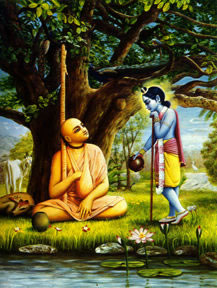 Question: Are you sure about the article, The Pontifical Position of Sri Madhavendra Puri. It was my understanding that Srimad Ananda Tirtha did in fact write his Bhagavad-Gita commentary *before* having darshan of Sri Vedavyasa. He then submitted this for the latter's approval. As I understand it, Srila Vyasa only had one comment about the text - something regarding the way Madhva began his commentary or ended it as my poor memory seems to recall. But the point here is that it indicates that Madhva began writing his Tattvavada commentaries *before* meeting with his claimed siksha guru. This calls into question then his exact relationship with Sri Vyasa. (H. Krishna Susarla)
Question: Are you sure about the article, The Pontifical Position of Sri Madhavendra Puri. It was my understanding that Srimad Ananda Tirtha did in fact write his Bhagavad-Gita commentary *before* having darshan of Sri Vedavyasa. He then submitted this for the latter's approval. As I understand it, Srila Vyasa only had one comment about the text - something regarding the way Madhva began his commentary or ended it as my poor memory seems to recall. But the point here is that it indicates that Madhva began writing his Tattvavada commentaries *before* meeting with his claimed siksha guru. This calls into question then his exact relationship with Sri Vyasa. (H. Krishna Susarla)
Narasingha Maharaja: Yes, I am sure of the matter but in my case the "sure" is a "heart thing" in that it relies more on the dictation of my sraddha than on my ability to reconstruct the chronology. However, Srila Bhaktisiddhanta Saraswati Thakur, our param-guru was the editor of The Harmonist when the article by Srila Sridhardeva Goswami was published. I think that I am safe to assume that the article met with his approval, otherwise it would not have been published. If there had been a mistake then we would have seen a retraction in the next issue. (I have the originals of the Harmonist from 1925 thru 1936, of course a few are missing.)
That it is sraddha that guides me in this regard must of course take me to a substantial plane also. Sraddha after all is a spiritual substance not an abstract conception.
Srila Saraswati Thakur had come to this world with a message. In the opinion of his disciples and followers he was a nitya-siddha, a liberated soul (Nayana-mani Manjari). An essential message in the preaching mission of Saraswati Thakur was that until one accepts the asraya-tattva, the shelter of the Supreme Lords agent, his advancement in Krishna consciousness does not begin.
The first principle of the 64 angas of sadhana-bhakti given in Bhakti-rasamrta-sindhu by Sri Rupa is guru-pada-asraya, i.e., acceptance of the shelter of the lotus feet of sad-gurudeva. Prior to Madhva's meeting and thus accepting the shelter and siksha of Vyasadeva the Gaudiya section is not prepared to concede that Madhva had a positive contribution to make. Therefore, it has been said that his preaching was in the line of destruction of the Mayavada theory. After his connection with Vysas his constructive preaching of establishing his cult of devotion began.
The asraya-tattva is a thing of spiritual substance not a mere formality or etiquette. One has to purchase it with saranagati, surrender. tad viddhi pranpatena pariprasnena sevaya. Pariprasnena - surrender. (Gita 4.34)
Study, learning, discourse on philosophy so many things are possible prior to initiation/diksha, but unless one gets this ashraya one does not gain admission to the descending flow of bhakti-rasa. (Harinama initiation is not considered diksha in the Gaudiya school. In Gaudiya diksha means mantra-diksha, klim kamadevaya....) To remain in that flow there are requirements also, not that just because I have taken shelter by initiation that I am always connected. This principle is so essential that even nitya-siddhas and the Supreme Lord Himself demonstrate its necessity by accepting guru-pada-asraya. In almost every instance it is shown that the missionary work of the nitya-siddha section begins after taking diksha. (Madhvacharya in this case as we are discussing.) Even Saraswati Thakura was himself no exception to this rule.
Question: Isn't it odd that Sri Chaitanya would take sannyasa initiation from a mayavadi (Keshava Bharati)?.
Narasingha Maharaja: Before accepting sannyasa-mantra, tat tvam asi (I am that), from Keshava Bharati Caitanya Mahaprabhu Himself first initiated Keshava Bharati with the same mantra, tat tvam asi, that he later received from him but with full-fledged Vaishnava conception (I am servant of him).
Mahaprabhu's acceptance of sannyasa is significant to the Gaudiyas in that it is the parallel lila where Krishna leaves Vrindavana which marks the beginning of the gopis feelings of separation, vipralambha-bhava. The Gaudiyas accept that Keshava Bharati was the self same Akura, the Uncle of Krishna, who took Krishna and Balarama to Mathura on the chariot. So, where is the question that Bharati was a Mayavadin and thus that Mahaprabhu took sannyasa from the Mayavadi section?
Question: Because Sri Madhavendra Puri's faith and love for Sri Krsna and his service was far too sublime and soaring he could not be considered a Mayavadin.
Narasingha Maharaja: For me this is a most central and attractive point in our discussion; at least central in that it leads to the core of Sri Caitanya Mahaprabhu's heart. His (Puri's) faith, love and service have been represented in the verse uttered by him before leaving his body. The verse is taken to have been spoken directly by Srimati Radharani and it is the actual foundation on which Mahaprabhu's sampradaya has been based, vipralambha-bhava. Thus needless to say this verse is classified in the prayojana-tattva of Gaudiyas
ayi dina-dayardra-natha he, mathuranatha kadavalokyase
hrdayam tvadaloka-kataram, dayita bhramyati kim karomy aham
"O my Lord! O most merciful Master of Mathura! When shall I see You again? Because of my not seeing You, my agitated heart has become unsteady. O most beloved one, what shall I do now? (Padyavali, Madhavendra Puri)
Sri Madhavendra Puri is the crest jewel among the Gaudiya Vaishnavas. What more can we say than this.
